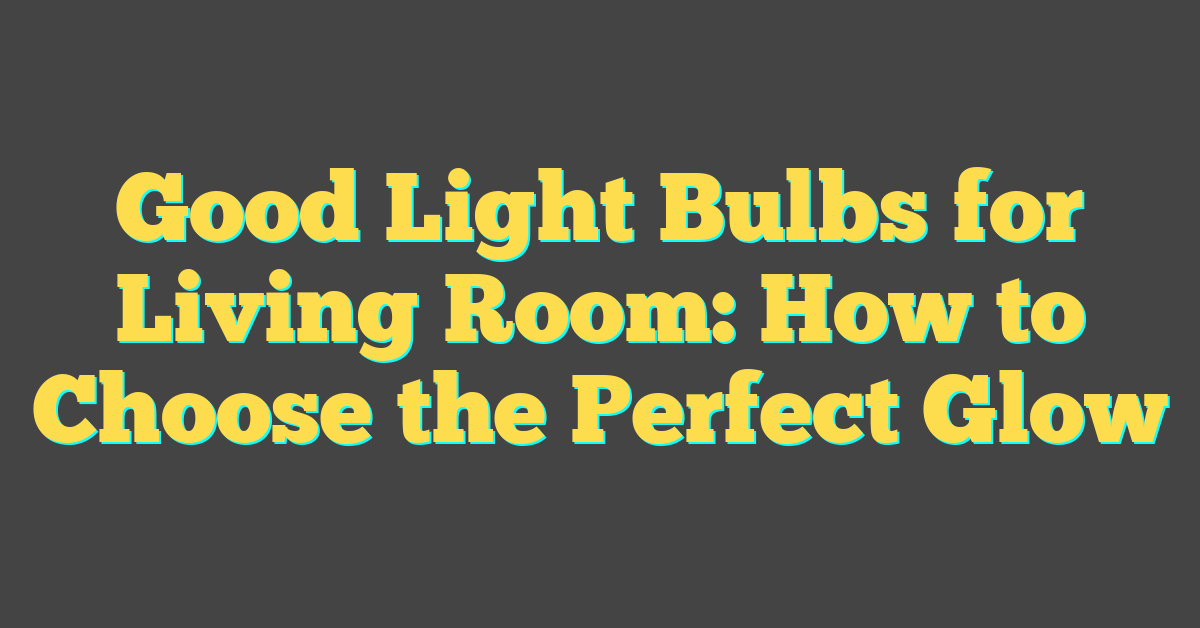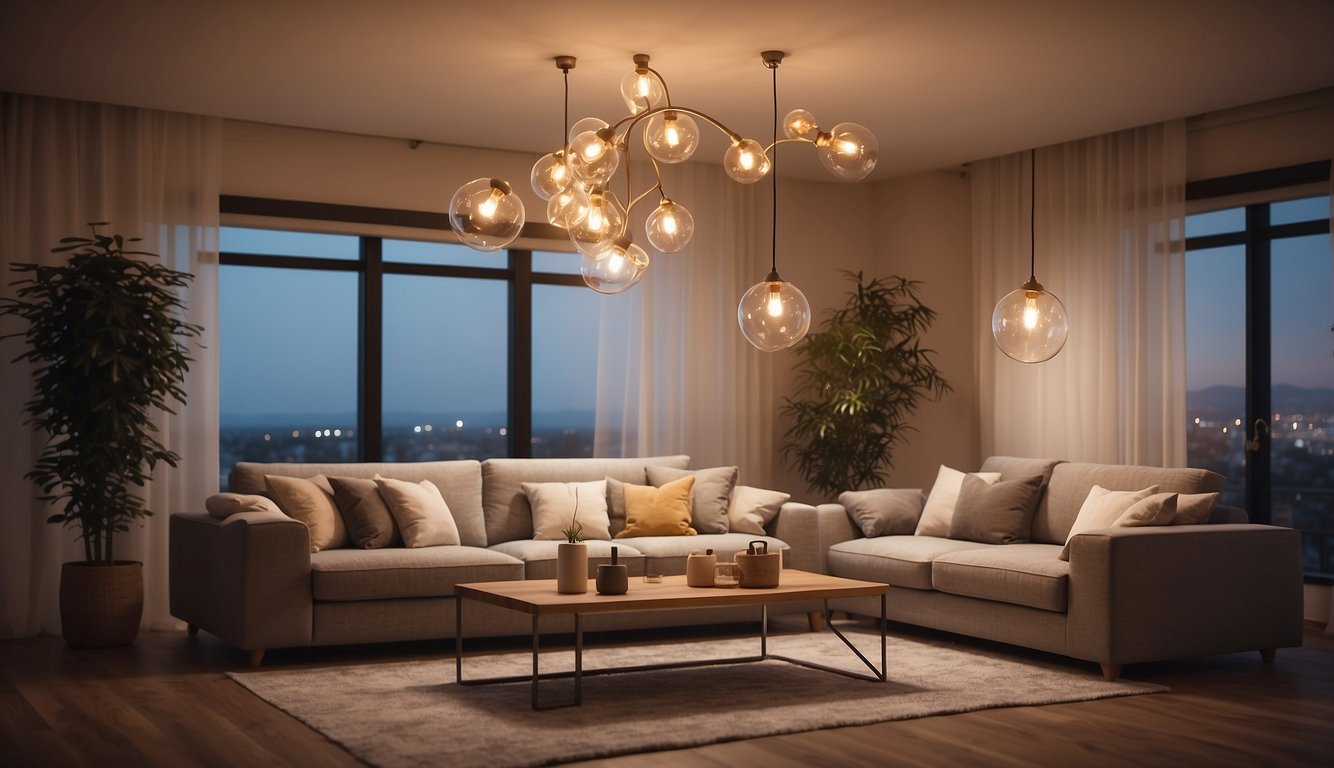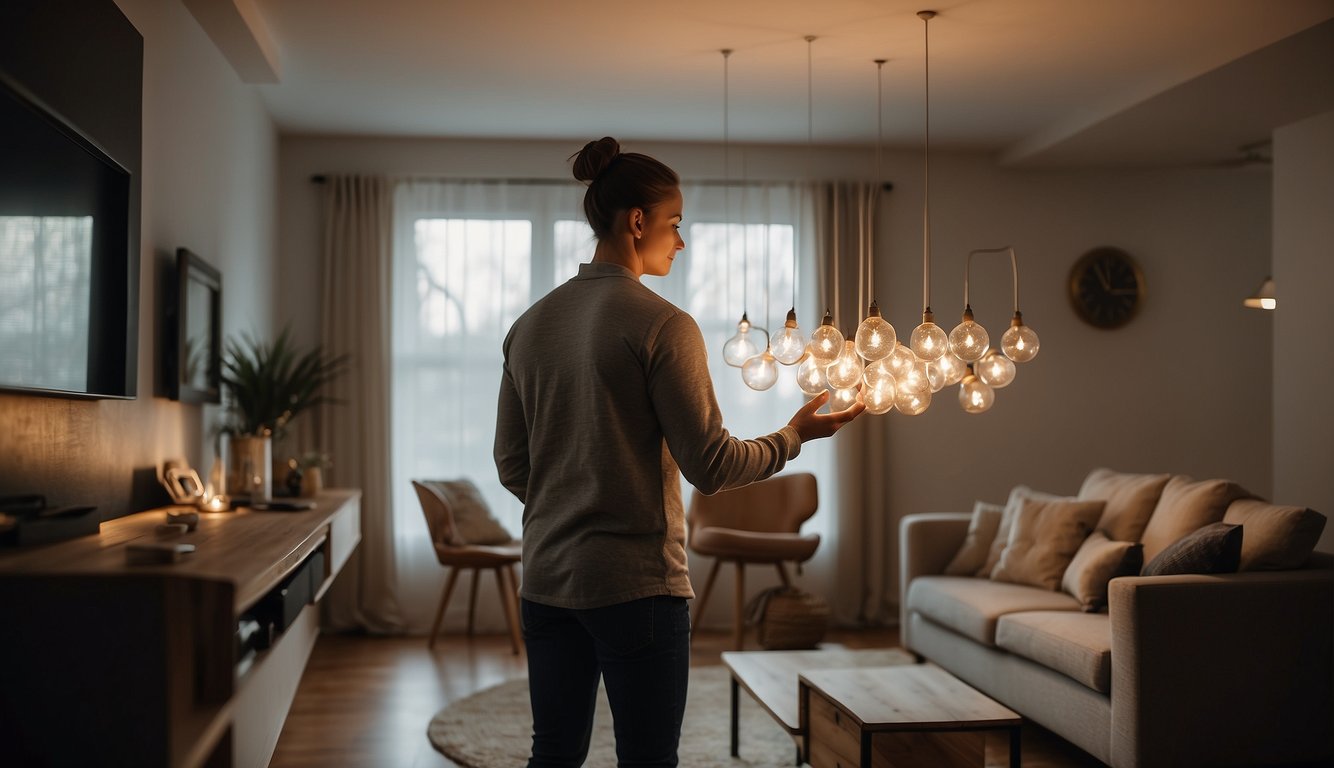Selecting the right light bulbs for your living room is essential for creating a comfortable and inviting space. The best lighting for this central area not only brightens the room but also enhances the ambiance, supports daily activities, and reflects your personal style. Whatever your living room needs may be, from reading to relaxing, modern light bulbs offer a range of options to cater to those moments.


Understanding the technology and features behind various light bulbs will help you illuminate your living room effectively. LED bulbs, for instance, are known for their energy efficiency and longer lifespan, making them a popular choice. Features like dimmable functions and different color temperatures can also transform the mood of the room, allowing for customization according to your preferences or the time of day.
Key Takeaways
- The best living room light bulbs enhance ambiance and support activities.
- It’s important to consider bulb features like dimming and color temperature.
- Energy-efficient options offer cost savings and longevity.
Understanding Light Bulb Basics
https://www.youtube.com/watch?v=Ei5vS-g4DTo&embed=true
When selecting light bulbs for your living room, you should consider both the brightness, measured in lumens, and the energy usage, measured in watts. Let’s break down these two essential factors to help you find the perfect balance between a cozy atmosphere and energy efficiency.
Lumens and Brightness
Lumens indicate how much light you get from a bulb; more lumens mean a brighter light. To set the right mood in your living room, a light bulb with about 1,600 lumens is typically sufficient. It’s important to note that lumens are entirely about brightness, not how much energy a bulb uses.
- Soft white bulbs (2,700 – 3,000K) usually provide a warm light suitable for living rooms and are available in various brightness levels.
- Bright white bulbs (3,500 – 4,100K) can give a more vibrant feel, suitable if you often read or work in your living room.
Watts and Energy Efficiency
While watts measure the energy a light bulb consumes, don’t confuse them with the brightness. A lower wattage means less energy use, which is key to improving your home’s energy efficiency. LEDs are a smart choice as they provide a considerable amount of light using fewer watts.
- Incandescent bulbs: These are less energy-efficient and use more watts for the same level of brightness. Switching to LEDs could save you up to 75% in energy.
- Comparing bulbs: An LED may only use 10 watts to provide the same brightness (lumens) that a 60-watt incandescent bulb would produce.
Adopting energy-efficient bulbs will not only reduce your living room’s energy consumption but also contribute to a greener planet.
Types of Light Bulbs
https://www.youtube.com/watch?v=vrMWHmPg0h8&embed=true
When selecting light bulbs for your living room, it’s important to consider the various types that are available. Each has distinct features and benefits suitable for different lighting needs.
LED Bulbs
LED (Light-emitting Diode) bulbs are recognized for their energy efficiency and long lifespan. They fit standard sockets and provide a bright, consistent light. Despite a higher upfront cost compared to other bulbs, LEDs save money in the long run due to their low energy consumption and reduced replacement frequency.
CFLs
Compact Fluorescent Lamps (CFLs) are another energy-saving option. They consume about 70% less energy than incandescent bulbs. One thing to remember about CFLs is that they contain a small amount of mercury, so they must be handled with care, especially when disposing of them.
Incandescent Bulbs
Incandescent bulbs are the traditional option you might be most familiar with. Although they are not as energy-efficient as LED or CFL bulbs and have a shorter lifespan, they offer a warm glow that is often desirable for cozy living room environments.
Halogen Light Bulbs
Halogen bulbs are a type of incandescent lighting but are more efficient and have a longer life than traditional incandescent bulbs. They produce a bright white light which can be perfect for reading or highlighting artwork in your living room. However, they can run hotter than other bulbs, so caution is advised when using them.
Color Temperature and Mood
https://www.youtube.com/watch?v=g74ZW6Bk6gA&embed=true
« Light Bulbs Similar to Sunlight: The Top Natural Light Options
Light Bulbs Good for Eyes: Choosing the Best for Vision Health »
Choosing the right light bulb for your living room impacts not just visibility but also the mood and atmosphere. Color temperature plays a central role in creating the desired ambiance in any space.
Soft White vs. Cool White
Soft White: You’ll find that soft white bulbs, which have a color temperature of approximately 2700K to 3000K, emit a warm, yellowish glow. They’re ideal for creating a cozy and welcoming atmosphere, making them excellent choices for living rooms where relaxation is a priority.
Cool White: In contrast, cool white bulbs, ranging around 4000K, provide a brighter and more neutral light that resembles natural daylight. This kind of lighting is often recommended where clarity and focus are needed but can still be used in your living room especially if it doubles as a workspace or if you prefer a modern aesthetic.
Warm White vs. Bright White
Warm White: This is slightly warmer compared to soft white and usually measures between 3000K and 3500K. Warm white lighting in your living room can enhance earthy and rich color schemes, bringing a sense of warmth and depth to your surroundings.
Bright White: Going higher on the color temperature scale, bright white light bulbs typically span 3500K to 4100K. These can be beneficial for your living room if you indulge in tasks that require attention to detail or if you want a light that sharpens visual contrasts without the starkness of cool white.
Smart Lighting Solutions
https://www.youtube.com/watch?v=k58yVRPGMas&embed=true
When selecting lighting for your living room, it’s essential to consider both functionality and ambiance. Smart lighting solutions offer you the convenience of controlling your lights with a smart speaker, integrating seamlessly with your smart home ecosystem.
Smart LED Bulbs
Philips Hue stands out with its White and Color Ambiance A19 Starter Kit, offering a full spectrum of colors along with white light. You can control these bulbs through a smart speaker or your smartphone, scheduling and adjusting lighting to match your daily routines. Smart LED bulbs like these promise energy efficiency and a long lifespan, ensuring you get both quality lighting and cost savings.
Smart Light Bulbs
For a more budget-friendly yet stylish option, consider the TP-Link Kasa Smart Bulb, which is praised for its ease of use. Although it doesn’t have dimming capabilities, its vintage design can add a unique touch to your living room. Smart light bulbs are a simple upgrade that can make a significant impact on the mood and convenience of your space.
Optimizing Living Room Lighting
https://www.youtube.com/watch?v=RR6bndDL_Jk&embed=true
To create a warm and inviting atmosphere in your living room, it’s essential to balance different types of lighting. Ambient lighting provides the overall illumination, while accent lighting highlights specific areas or objects. Paying attention to these details can transform your space.
Ambient Lighting
Ambient lighting is the base layer of light in your living room, casting an even glow that allows you to navigate the space safely. For the best experience, choose bulbs with a soft white temperature that are dimmable to adjust the brightness according to different times of the day. A central fixture, like a chandelier or recessed can lights, often provides ambient lighting.
Accent Lighting
Use accent lighting to draw attention to the elements in your living room that make it unique, such as artwork, architectural details, or a cozy reading nook. Wall sconces are an excellent choice for creating visual interest and adding layers to your lighting scheme. Position them around the room at eye level to highlight specific features or objects.
Choosing the Right Shape and Size

When selecting light bulbs for your living room, you’ll find shape and size to be crucial considerations. Different bulb shapes diffuse light uniquely, affecting the ambiance of the room.
- A19 Bulbs: These are your standard bulbs that fit most table lamps. The familiar bulb shape provides even light distribution, making them versatile for general lighting.
- B10 Bulbs: These are often found in chandeliers or decorative fixtures. Their flame-like shape is suited for fixtures where the bulb is visible and contributes to the aesthetic.
- Globe Bulbs (G series): Globe bulbs, with their round shape, are ideal for vanity mirrors and offer a soft light spread.
- Flood Bulbs (BR series/R series): These are suitable for recessed fixtures or track lighting, perfect for highlighting certain features like artwork.
Remember, the size of the bulb should complement the fixture. For example, a bulb too large for a table lamp may protrude awkwardly, while a bulb too small may get lost in a large pendant shade.
Here’s a quick reference for bulb shapes:
| Bulb Shape | Ideal For |
|---|---|
| A19 | Table lamps, standard lamps |
| B10 | Decorative, visible fixtures |
| Globe | Vanity mirrors, bathrooms |
| Flood | Recessed, track lighting |
Finally, look for a size that corresponds well with the scale of your fixture. This balance ensures the bulb does not overwhelm or underwhelm the space. Keep your living room’s aesthetic and functional needs in mind to create a warm and welcoming environment.
Energy Star Certification and Savings
https://www.youtube.com/watch?v=DUyTFLN4JlU&embed=true
When you’re on the hunt for light bulbs for your living room, consider options with Energy Star certification. This certification means the bulbs meet strict energy efficiency guidelines set by the U.S. Environmental Protection Agency. By choosing Energy Star certified bulbs, you’re selecting products that use up to 90% less energy than standard bulbs, which can lead to significant electricity cost savings over time.
Energy Star Certified Light Bulbs:
- Last longer: Typically, they endure 15 times more than non-certified bulbs.
- Save money: You can save about $55 in electricity costs over the bulb’s lifetime.
- Quality performance: Not just energy savers, they also deliver consistent light quality and color.
Chart of Savings
| Standard Bulb | Energy Star Bulb |
|---|---|
| 100% Energy Use | Up to 90% Less Energy |
| Short Lifespan | 15x Longer Lifespan |
| Higher Costs | Saves ~$55 Over Lifetime |
Remember, by investing in Energy Star certified LED bulbs, you’re not just brightening your space; you’re also supporting environmental sustainability. As they reduce the demand for energy generation, there’s a subsequent decrease in greenhouse gas emissions. It’s a smart choice for both your wallet and the planet.
For more detailed information, check out Choosing the Right Energy Star Certified LED Bulb and the EPA Energy Star’s List of Certified Light Bulbs to find the best fit for your living room.
Addressing Common Lighting Issues
https://www.youtube.com/watch?v=mwXhMdoccu8&embed=true
When setting up lighting in your living room, you might come across a few common issues such as flickering lights and inaccurate colors that can affect the ambiance. Let’s address these so you can ensure your space is both comfortable and functional.
Flicker and Buzz
Flickering can often be caused by a mismatch between your light bulb and your dimmer switch. To fix this, ensure you’re using bulbs compatible with your dimmer model. If a bulb is compatible but still flickers, consider replacing the switch with one that’s designed for LED bulbs if you haven’t already. Buzzing noises are usually related to the dimmer as well. For optimal performance, use a dimmer that specifically matches the power requirements of your LED bulbs.
Glare and Color Accuracy
Glare can be reduced by positioning bulbs correctly and choosing fixtures with shades or diffusers. It’s essential for comfortable lighting, especially if you have reflective surfaces in your living room. Regarding color accuracy, look at the Color Rendering Index (CRI) of your bulbs. You’ll want a CRI of 80 or above for your living room to ensure that colors appear true to life and vibrant. Color accuracy is key in creating a warm and inviting atmosphere, so opt for bulbs that advertise high CRI ratings.
Lighting Controls and Accessories

When elevating the comfort and ambiance of your living room, don’t overlook the impact of lighting controls and accessories. These elements not only provide convenience but also enhance the functionality and mood of your space.
Dimmer Switches
Dimmer switches allow you to adjust the brightness of your lights, giving you control over the intensity and atmosphere in your living room. Lutron is a reputable brand offering a range of dimmable products that can fit different lighting scenarios. Whether you’re reading, hosting guests, or enjoying a quiet evening, a dimmer switch can match your light to the activity.
Lighting Fixtures
Your choice of lighting fixtures also plays a pivotal role in your living room’s overall feel. Options that support dimmability let you personalize brightness levels to your liking. Consider pairing elegant fixtures with dimmer switches for a versatile lighting scheme that can be tailored for any occasion.
Longevity and Warranty

When selecting light bulbs for your living room, you’ll want to consider both how long the bulbs will last and the warranty coverage. These factors can greatly impact your satisfaction and the value you get from your purchase over time.
Bulb Lifespan
Most LED light bulbs boast a significant lifespan compared to traditional incandescent bulbs. Typically, you can expect your LED light bulbs to last anywhere from 15,000 to 25,000 hours. This means if you use your living room lights for about three hours a day, your bulbs could light up your space for up to 22 years. You’ll save money and time since you won’t need to replace your bulbs as often.
Warranty Terms
A good warranty offers peace of mind and protection for your purchase. Many manufacturers offer a five-year warranty on LED light bulbs, ensuring that they’ll either replace or repair the bulb if it fails prematurely. Always be sure to check the warranty terms before buying to understand what’s covered, the claim process, and any exclusions that may apply. It’s a simple step that might save you hassle in the future.




